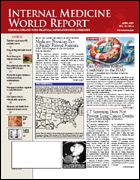Publication
Article
Internal Medicine World Report
Chronic Rhinosinusitis: Common Misconceptions, Mistreatments
Author(s):
From the American Academy of Allergy, Asthma & ImmunologySteroid Sprays or Systemic Steroids Routinely Needed
SAN DIEGO—Chronic rhinosinusitis needs to be more aggressively managed, much in the same way that asthma is currently managed, investigators argued when presenting new data at the American Academy of Allergy, Asthma & Immunology annual meeting.
Chronic rhinosinusitis is an inflammatory disease of the upper respiratory tract that many patients mistakenly think could be cured with a 2- to 6- week course of antibiotics or a simple surgical procedure. But because there are likely several etiologies, not only bacterial, treatments designed to address bacterial infection only will not work for a large percentage of patients. Similarly, surgical interventions cannot address the underlying inflammation.
“Physicians need to be aware that you need to decrease inflammation and minimize it on a continual basis to get these patients to a good level of functioning,” said John Krouse, MD, PhD, professor and vice chair, Department of Otolaryngology, Wayne State University School of Medicine, Detroit, Mich. “Chronic rhinosinusitis is definitely being undertreated.”
Dr Krouse highlighted these treatment strategies:
• All patients should be using topical corticosteroid sprays routinely
• Those with polyposis may need much higher doses
• Some patients may also need systemic corticosteroids.
He recommends that physicians use a conceptual framework that addresses the interaction between adynamic and dynamic features. Adynamic factors are the fixed obstructions that interfere with the ventilation and drainage of the sinuses. These include septal deformity, turbinate abnormalities, abnormal pneumatization of cells, and the accumulation of fibrotic tissue.
The dynamic factors vary and can include viral and bacterial infections, fungal colonization, and immune responses such as immunoglobulin E–mediated allergic disease.
Effective management depends on an adequate analysis of the relative contributions of these dynamic and adynamic factors in each patient. Broad-spectrum antibiotics are now used as first-line therapy for 4 to 6 weeks. But Dr Krouse said that intranasal steroids, saline irrigation, and leukotriene modifiers are also important.
IMWR
“To manage this chronic disease, you need different modes of therapy, and you need to provide ongoing care. You are not going to cure it with any one single method,” Dr Krouse told .
“The main misconception is that this is a disease that can be managed with antibiotics alone, and if you give enough antibiotics you can cure the disease. We now know that is certainly not the case.”
You must individualize therapy, Dr Krouse emphasized. Find out what a patient’s individual triggers are and what roles allergic disease or fungi may be playing. He said that although surgery may help patients with structural abnormalities or chronic polyps, it is not a long-term cure.
IMWR
Raymond G. Slavin, MD, director, Section of Allergy & Immunology at St. Louis University School of Medicine, Mo, agrees. “Surgery is sometimes oversold. I see patients who have had more than 1 operation for the chronic sinusitis, and for many of these people surgery does nothing [because] there is really nothing anatomically wrong…. There is no bone spur, no deviated septum, no nasal polyps—nothing structurally that is interfering with drainage,” he told .
Key points
• Chronic rhinosinusitis cannot be managed with antibiotics alone.
• All patients should be routinely using an intranasal steroid spray.
• Therapy should be individualized, based on triggers, the contribution of allergies or fungi, andthe presence of structural abnormalities.






